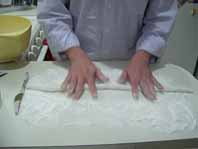Many people enjoy browsing through cookbooks at the end of the day, preferring a few moments of culinary immersion before drifting off into sweet slumber. Unfortunately I have never been one of those people. Picking up any book at bedtime usually lasts only a few minutes before I yawn widely, close both my book and my eyes, and settle dreamily into my pillow.
But lately I’ve been staying awake a little longer. For the past few weeks Nigel Slater’s The Kitchen Diaries has provided me with pages of food-related comfort before turning off the bedside lamp.
Nigel Slater is an English food writer who favors a simple, straightforward style of cooking. The Kitchen Diaries, published in 2006, is basically a chronicle of what he cooked and ate for a year. Casual recipes favor a bunch of this and a knob of that instead of absolute, rigorous measurements, and are interlaced with the author’s observations on cooking, fresh produce, and daily cravings.
The book is broken down into months and days, providing an intimate look at Slater’s natural, understated approach to food. Lush photography of his seasonal and rustic dishes printed on off-white, uncoated paper contributes to the well-crafted and personal feel of the book. At night I find myself paging through the photographs, enjoying the almost-finished chocolate almond cake on one page, and the gorgeous roasted pumpkin with spicy tomato sauce on another.

I’m barely a third of the way through the book (I reached the month of April last night), so I feel a little strange writing about it now. But I imagine it will reside on my nightstand for some time as I read a few pages here and there. I’ve posted a photo of a free-form peach tart I made over the summer; I never wrote about it because I was embarrassed by its burned edges and lopsided folds of dough. But six months later, I still find myself thinking of those peaches baked at the height of the summer season, paired with one of my first homemade pie crusts. It was a simple and honest little pie. I think Nigel Slater would approve.









 Subscribe to the Choke
Subscribe to the Choke 
